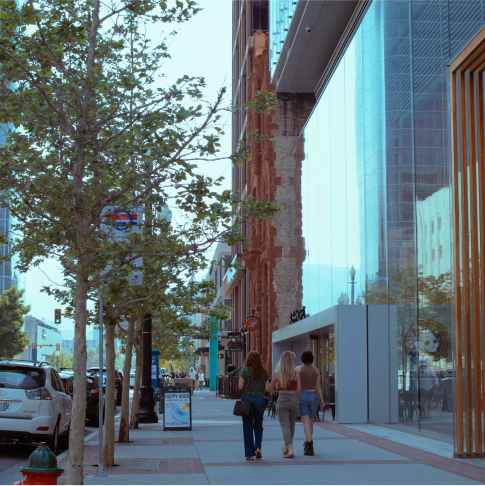
Annual Report 2022-2023
Download The PDF Format Here:
Download PDFMission & Values
The mission of the Redevelopment Agency of Salt Lake City is to strengthen neighborhoods and business districts to improve livability, create economic opportunity, and foster authentic, equitable communities, serving as a catalyst for strategic development projects that enhance the City’s housing opportunities, commercial vitality, public spaces, and environmental sustainability.
- Economic Opportunity – We invest in the long-term prosperity and growth of our local economy.
- Equity & Inclusion – We prioritize people-focused projects and programs that encourage everyone to participate in and benefit from development decisions that shape their communities.
- Neighborhood Vibrancy – We cultivate distinct and livable places that are contextually sensitive, durable, connected, and sustainable.
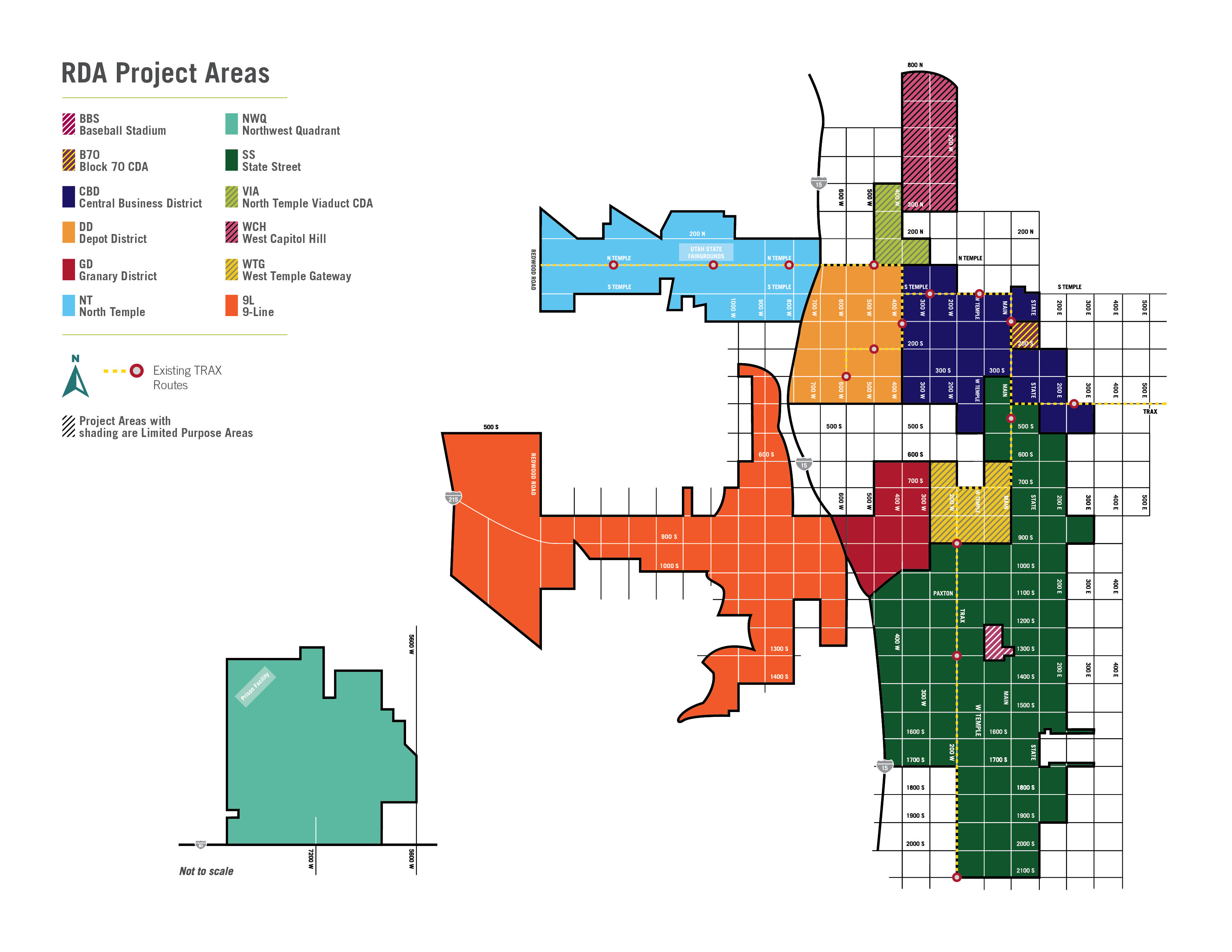
Under the Utah Code Title 17C Community Reinvestment Agencies Act, the RDA creates and administers community reinvestment areas, also known as “project areas,” working with community councils, property owners, neighborhood residents, and businesses to learn how they would like to see their communities improved. Per 17C, the RDA is also authorized to undertake affordable housing projects citywide, in addition to those located within project areas.
The community reinvestment projects we take on include a wide range of elements, such as residential, commercial, historic preservation, public art, environmental, infrastructure, economic development, and placemaking. This annual report includes updates on the RDA’s projects that have experienced substantial progress over fiscal year 2023 (July 2022 to June 2023).
Leadership & Staff
Erin Mendenhall
Executive Director
Director
Deputy Director
Financial Analyst
Project Coordinator
Comm/Engagement Manager
Comm/Engagement Coordinator
Project Manager
Data Manager
Office Facilitator
Project Coordinator
Special Project Assistant
Senior Project Manager
Senior Project Manager
Senior Project Manager
Property Manager
Office Manager
Project Manager
Senior Project Manager
Project Manager
Board of Directors
Dan Dugan, Vice Chair
Redevelopment Advisory Committee
Finance Committee
Redevelopment Agency
Dept. of Community and Neighborhoods
Affordable Housing
Truly vibrant neighborhoods are built with equity and inclusion in mind. They’re residential spaces where the creation and preservation of affordable housing are prioritized, and mixed-income communities are made possible. The State of Utah authorizes us to fund and support affordable housing projects anywhere within City limits – not only within our project areas. During the 2022-2023 fiscal year, the RDA helped add 275 affordable units to Salt Lake City’s housing stock with the completion of three major residential projects: The Aster, Colony B, and Paperbox Lofts, with others in the works.
The Aster
255 S. State Street
In the spring of 2023, we cut the ribbon on one of the City’s most monumental affordable housing developments to date! The 1.1-acre site has a mix of vibrant uses, both residential and commercial. The Aster contains 190 units ranging in size from studios to 4 bedrooms. These units are designated as deed-restricted to households making 20% to 80% of the area median income (AMI), with over half of the units listed at 50% AMI or below.
In addition, this mixed-use building contains 18,000 square feet of ground-floor commercial space, resident amenity space, as well as a publicly accessible midblock walkway. The project also includes the preservation and rehabilitation of the property’s historic Cramer House and 71 subterranean parking stalls.
In total, the RDA Board of Directors approved $14.5 million in funding for this $88 million project from Brinshore Development, LLC. The developer utilized other funding from a variety of local and federal sources, including 9% and 4% Low-Income Housing Tax Credits (LIHTC) and tax-exempt bonds.
Construction began in January 2021, and the project was completed in May 2023. The Aster received the annual Downtown Creator Award from the Downtown Alliance.
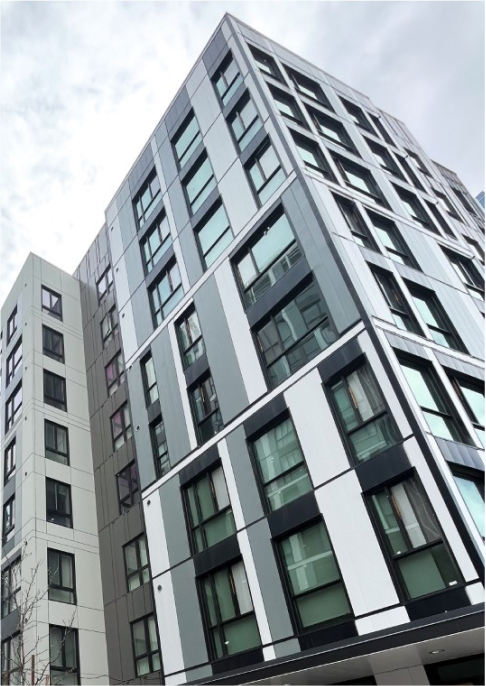
Paperbox Lofts
340 W. 200 South
The 1.99-acre site of Downtown’s former Utah Paperbox production warehouse has undergone quite the change. Paperbox Lofts mixed-use development features 156 market-rate residential units, 39 affordable residential units, public open space, and mid-block connections to both 200 South and 300 West.
The RDA originally purchased the property as part of a negotiation with the owners of Utah Paperbox to relocate to a larger site within the City’s Glendale neighborhood that was being used as a noxious tire-recycling facility. The RDA’s selection of Paperbox Lofts codevelopers – PEG and ClearWater Homes – gave way to a collaborative design that utilized the parcel’s unique location on the interior of the large Downtown block.
The RDA provided a $3.2-million land write-down in exchange for the inclusion of residential units affordable to households earning 60% of the area median income.
One of the unique features of this project is its use of two “car stacker” parking lift systems, which accommodate 126 cars in the footprint of 27 surface lot spaces.
The project was completed in June 2023.
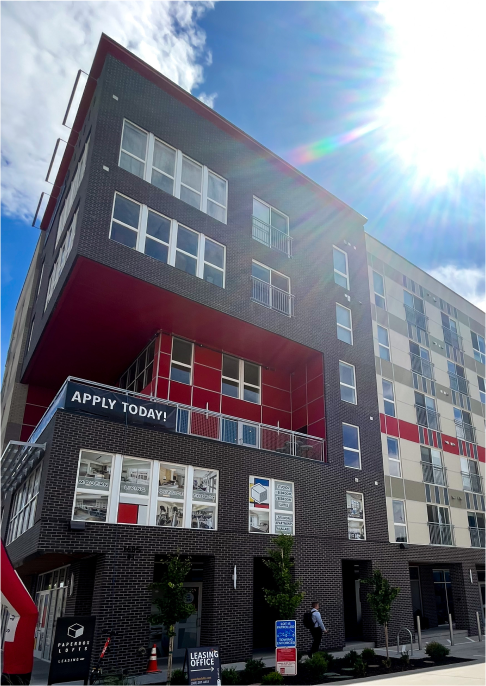
The Nest at Rio Grande
382 S. Rio Grande
This spring, we closed on a $1.1 million loan with the developers of The Nest, a housing development that will feature 220 units affordable to those earning 60% of the Area Median Income (AMI) and below. The project will include 72 parking structured and surface parking stalls. Ground has been broken and it’s expected to be completed in late 2024.
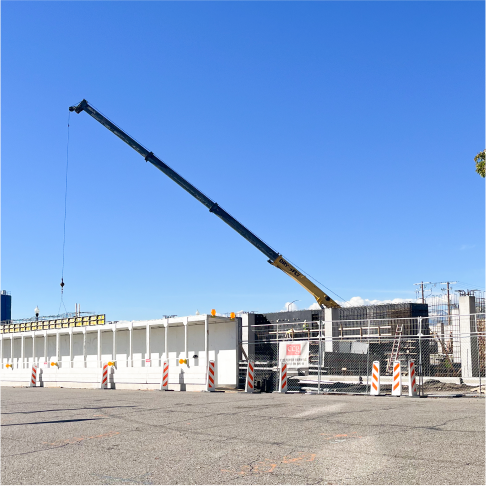
Spark
1500 W. North Temple Blvd.
In May, the we broke ground on the Spark mixed-use project on the site of the former dilapidated Overniter Motel, which the RDA purchased with the intention of creating a transit-oriented cornerstone for the North Temple neighborhood. Located across from a TRAX station on the corner of a transit corridor (North Temple Blvd.) and two residential-adjacent side streets (Cornell St. and 1460 West), the 2-acre site will feature a number of pedestrian and street-level touchpoints.
Through a public process, the RDA selected Brinshore Development, LLC to bring this mixed-use project to life. The Spark project will include affordable and market-rate housing units, ground-floor retail, neighborhood services, and public open space.
Estimated to cost $96 million to build, the Spark project received $14.5 million in RDA funds and an additional $1 million from the City’s Housing Stability Division.
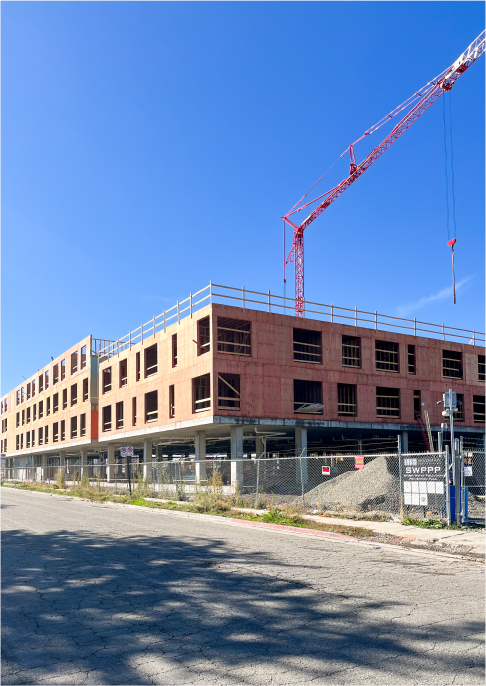
Colony B
228 W. 1300 South
Colony B is a transit-oriented residential development built with affordability and access in mind. Of the development’s 140 total studio- and one-bedroom units, 106 are rented at rates affordable to people earning 25 to 50% of the area median income (AMI).
The RDA provided a $1.34 million loan to help finance Colony B’s construction both because of its affordability and its intentional focus on serving vulnerable populations. Eleven (11) units are specially reserved for young people aging out of the foster care system, and 15 units are ADA-accessible. Additionally, it is steps away from the 1300 South TRAX station, enabling residents easy access to transit.
In early 2023, residents began living in this lively and connected environment enjoying access to indoor bicycle storage, a gym, and multiple community lounges.

City Lofts
230 W. 1700 South
Early in the year, the RDA provided $1 million in emergency gap financing to developers, Wasatch Residential Group, to ensure the continued construction of the in-progress 1700 South Affordable project, which had experienced unprecedented cost overages due to supply chain issues. Now completed and called City Lofts, this 3.06-acre project has added 237 affordable units to the City’s housing stock, with each unit rented to those earning at or below 60% of the area’s median income (AMI). The unit mix comprises 24 studio apartments, 130 one-bedroom units, 73 two-bedroom units, and ten three-bedroom units. On-site community amenities include a pool, spa, sun deck with BBQ grills and seating, a large open courtyard, energy efficient windows, pet-friendly amenities, access for persons with disabilities, covered parking, exercise gym facility, and 24-hour emergency maintenance services. Its closeness to nearby restaurants and retail makes this project an ideal location for workforce affordable housing.
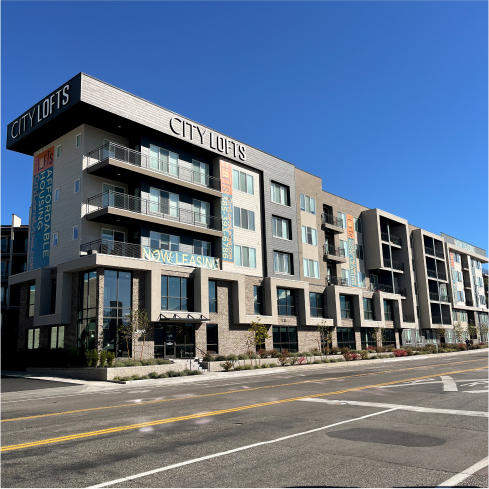
Richmond Flats
2960 S. Richmond Street
Located just along the City’s eastern border, Richmond Flats is slated to provide much-needed affordable housing in the City’s east-side neighborhood. In 2019, the RDA Board approved a land acquisition loan of $1.8 million to develop the Richmond Flats project.
This 55-unit affordable housing development will include one-, two-, and three-bedroom units that will be 100% affordable to households earning between 25% and 55% of the area median income.
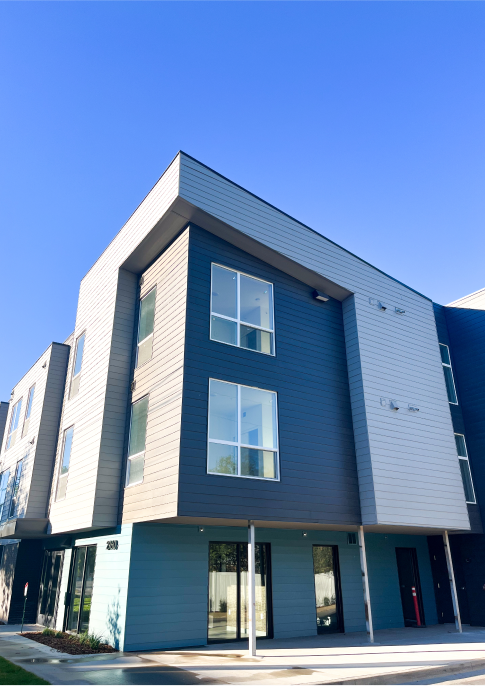
144 S. 500 East
Construction is well under-way at 144 S. and 500 East where some of Salt Lake City’s newest affordable units are being built. In fact, this development will add an additional 110 affordable units to the City’s housing stock. These units will be rented to people earning at or below 60% of the area median income (AMI).
Furthermore, this project is designed to be energy-efficient and environmentally friendly. It will meet and exceed the 90+ ENERGY STAR score and 100% electric thresholds required by our Sustainable Development Policy.
The apartments are located in a prime area, making them ideal for those who work in the Downtown area and want to reside in the Central City neighborhood. This location offers easy access to various amenities, including shops, restaurants, and public transportation.
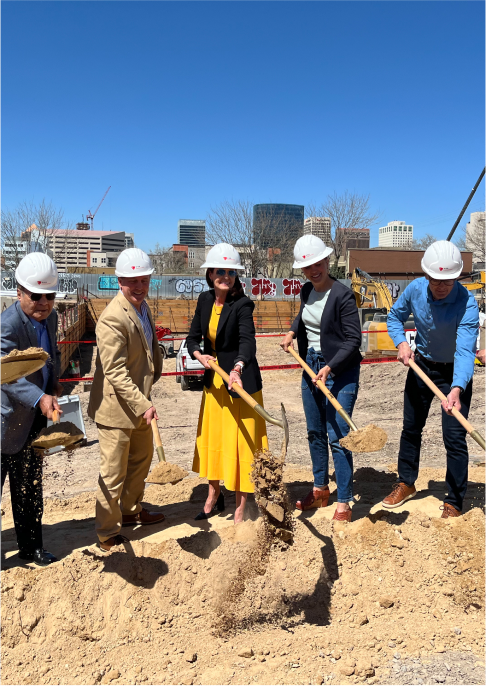
Commercial & Mixed Use
While many elements make up a sound and livable neighborhood, integrating accessible commercial space into residential projects is one of the ways we can contribute to residents’ access to the things they want and need. Blending residential and commercial areas is often what makes a community bustle, and a neighborhood truly comes to life when residents and visitors stop by ground-floor storefronts to shop and local restaurants to dine. We prioritize commercial and mixed-use projects that counter the displacement of existing businesses and establish new services, amenities, and underrepresented business types in our Salt Lake City neighborhoods.
Bicycle Collective
325 W. 900 South
The Bicycle Collective’s new location in the Granary neighborhood will provide an array of transportation resources and activities and will attract daily shoppers, visitors, employees, and volunteers to the neighborhood. The Collective’s multi-use building will feature a retail space, a community bicycle repair shop, a professional workspace for mechanics, classrooms, administrative workspaces, and a storage area for donated bicycles.
Because of the Collective’s social impact, the neighborhood activation and amenities the organization will bring, and the sustainable building design, the RDA Board wrote down the entire cost of the $280,000 land and also provided a $2.25 million loan for the project. Construction commenced after a celebratory groundbreaking event in late 2022, and the building is slated to be completed by the end of 2023.
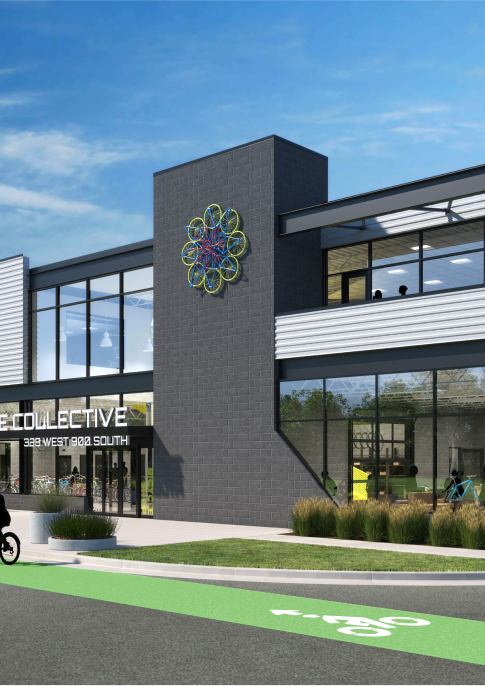
Fisher Brewing
320 W. 800 South, Salt Lake City, UT 84101
The Granary District Adaptive Reuse Program is an RDA initiative that offers forgivable loans to help convert vacant and underutilized buildings in the Granary District. Through this program, we provided a $136,962 loan to Fisher Brewing. With this funding, they were able to expand their brewery, adding more tavern space, brewing areas, and outdoor dining facilities. These features will further activate the Granary neighborhood and bring people into the area for productive purposes.
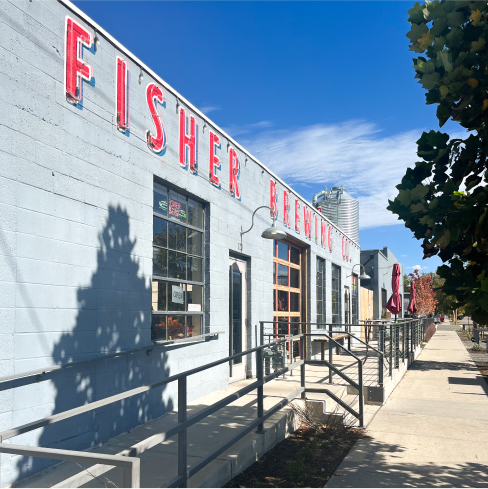
Asher Adams Hotel
18 N. Rio Grande Street
In the summer of 2022, the RDA closed a $7 million loan for the development of the Asher Adams Hotel. This project entails the adaptive reuse of the Union Pacific Depot building, a historic landmark situated in the Depot District project area at the Gateway. As a result of this development, the public will have access to the repurposed building, several full-time and year-round jobs will be created, new hospitality offerings will be available, and the tax base will be increased, which will benefit the community at large. It is currently well underway, and is projected to be completed in 2024.
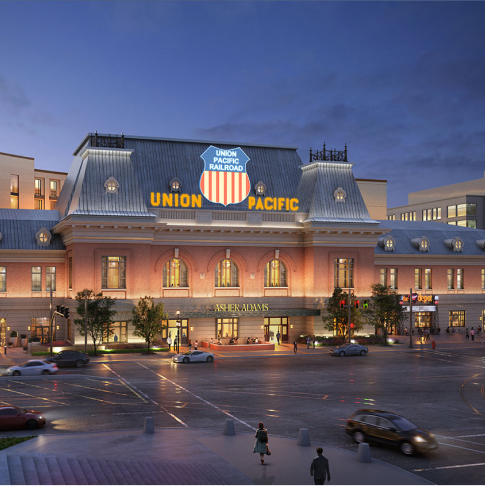
Northwest Quadrant
In 2020, the RDA entered into a tax increment reimbursement agreement (TIRA) with NWQ LLC for the development of the SLC Port Global Logistics Center. The Center is a 3,000-acre industrial development that is served by rail and can accommodate manufacturing, warehouse, and distribution tenants of varying size. The TIRA is for the first phase of the development, covering approximately 378 acres of land and providing for the development of approximately 6 million square feet of light industrial space (Phase I). Two buildings were completed in 2021 and several others are currently under construction. Private investment for the planned system-wide improvements and the Phase I development includes over $310 million in capital expenditures, generating approximately 6 million square feet of development to support over 2,900 jobs.
Arts, Culture, & Public Improvements
Arts and culture play a crucial role in the telling and understanding of a city’s story. They help connect residents and visitors and create a sense of place. That’s why we take part in redevelopment projects that build, enhance, and preserve cultural districts and community spaces. Part of our work entails funding public art that instills a sense of neighborhood pride and energizes public spaces. In prioritizing this work, we aim to ensure that Salt Lake City remains a place where our City’s culture can thrive and the arts can flourish.
Main Street Pedestrian Mall Conceptual Design Study
Main Street from South Temple to 400 South
Over the last three years, Salt Lake City has been hosting the Open Streets event, an annual summer occasion where Main Street is closed off to cars, allowing pedestrians to enjoy the full use of the roadway. During this time, businesses can expand their retail and dining options onto the sidewalks, making them more accessible to the public. The event has been immensely successful and well-received.
Currently, we are partnering with Salt Lake City’s Department of Economic Development, Transportation, and Planning to explore the possibility of creating a permanent pedestrian mall on Main Street. A conceptual design study that will provide a clear vision, high-level recommendations, and a roadmap for implementation is currently in the works. We pride ourselves on partnering with other City entities to invest in initiatives that will benefit residents, businesses, and visitors alike.

Future of Gallivan
239 S. Main Street
In January 2023, we published a request for proposals for the creation of a plan that will guide how the Gallivan Center can best serve the needs of the ever-evolving community in an equitable, environmentally sustainable, and fiscally conscious manner over the next decades. Through assessment of existing conditions, research and analysis of the Downtown population, and community engagement, a 20-Year Plaza Plan will be created. Broken out into 5- and 20-year implementation strategies, the Plan will include recommendations for wayfinding and signage solutions, maintenance and repair projects and budgets, capital projects planning, sustainable infrastructure enhancements, and equitable programming. The plan is estimated to be finalized in the spring of 2024.

9 Line Property Purchase
877 W. 400 South
This year, we purchased the property previously owned by the Tongan United Methodist Church located in our 9 Line Project Area at. Our team is currently exploring mixed-use development scenarios for the property, which will help craft a future Request for Proposals for the development of the property.
We are working to align this project with the City’s Westside Master Plan, which calls for the intersection to become a “community node” or integrated center of activity representative of the surrounding community. We aim to develop the property in a way that is consistent with this vision.
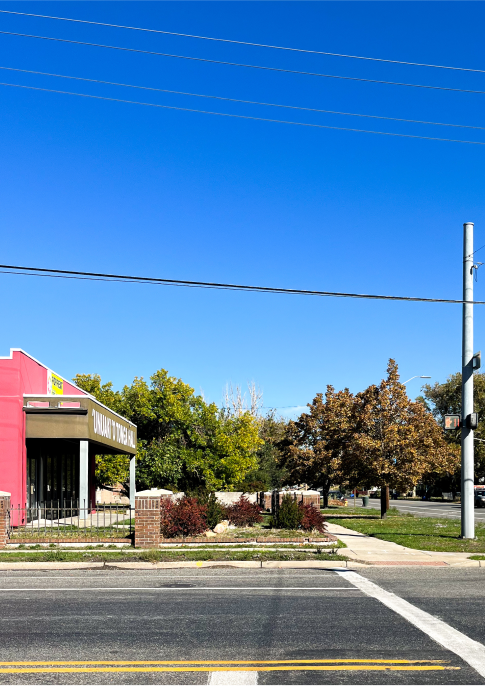
Station Center Vision and Implementation Plan
Approximately 500 West and 300 South
Since March 2023, we have collaborated with a consultant to develop the Station Center Vision & Implementation Plan. This comprehensive plan will serve as a blueprint for the development, programming, and governance of approximately 14 acres of RDA-owned property situated in west downtown Salt Lake City. The project aims to undertake environmental remediation, construct new street connections, transform 300 South into a shared street with public gathering spaces, build parking structures that can be shared by multiple neighborhood users, and repurpose one or more historic warehouse structures. The Plan is expected to be completed by Fall 2023, after which our team will issue a Request for Proposals (RFP) for the first phase of development.
Folsom Trail-Adjacent Property Acquisition
22 S. Jeremy Street
The RDA Board approved allocating $1.11 million of North Temple Strategic Intervention Funds to acquire the Schovaers Electronics property near the recently completed Folsom Trail.
We are excited about the building’s potential for adaptive reuse. By transforming the old Schoaver’s structure, we aim to support the RDA’s goals of establishing smaller-scale, trail-oriented developments in the area. However, it’s important to note that historical on-site and off-site industrial activities contaminated the property. Fortunately, the Environmental Protection Agency (EPA) awarded the RDA with the necessary funding to conduct an environmental cleanup, making it possible to safely develop this land.
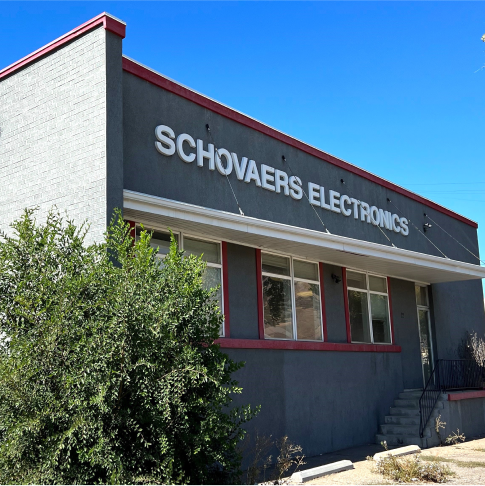
Folsom Trail/City Creek Daylighting
Folsom Avenue at 1000 West
Phase I of development and the paving of the North Temple neighborhood’s Folsom Trail is officially complete. Following what was once a rail corridor, this mile-long paved trail leads residents from 500 West at approximately 40 South to 1000 West and provides increased access points to transportation routes, open green space, and to serve as a safe place to exercise and enjoy nature.
Over the years, studies and plans were carefully conducted and designed, funding sources were identified, and entities joined together to make Folsom Trail a reality. Our team has enjoyed partnering with the Utah Transit Authority and Salt Lake City’s Transportation Division, Engineering Division, and Public Lands Department to help bring this urban trail to life and better connect the City’s east and west sides. We are currently working with Seven Canyons Trust on a design to bring sections of City Creek up to the surface along the Folsom Corridor.

Ballpark Design Competition and Community Engagement
77 W. 1300 South
With the announcement of the Salt Lake Bees’s upcoming move to South Jordan, the City launched the Ballpark NEXT Design Competition. The competition was an opportunity for residents, post-secondary students, and development professionals to envision the future of the Smith’s Ballpark site. This RDA-lead project took place over the course of a few months and received 123 applications. Winners were announced in May, and although the winning proposals will not be built as submitted, the themes gathered from all participants will be utilized in the next phase of the project: Community Visioning. This visioning process works with residents, neighborhood businesses and organizations, and area stakeholders to create the Ballpark NEXT Guiding Principles, which will help inform the vision for the Ballpark site and next steps of the development process.
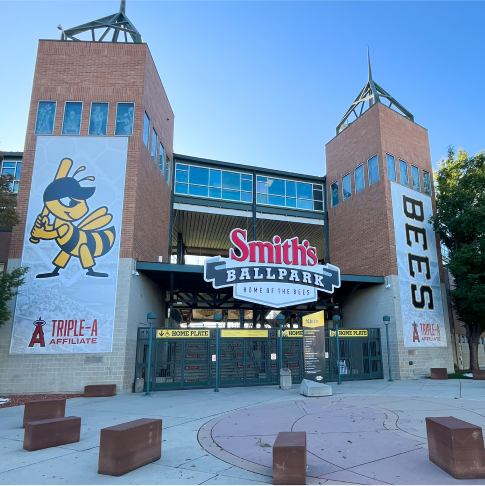
Central Ninth Streetscape Completion
900 South, from West Temple to 300 West
Construction of the Central Ninth Streetscape is nearly complete. Prior to this project, Salt Lake City’s Central Ninth Neighborhood was in need of a neighborhood “main street”—a place for residents to meet, dine, shop, and enjoy the amenities urban living has to offer. The RDA and City came together to design and implement this vision.
This project added plentiful on-street parking for businesses, created a new two-way cycle track and wider sidewalks, buried all utility infrastructure, and planted dozens of new street trees. To date, we have contributed $7.3 million to make the 900 South vision a reality.
We are proud to say that, with the help of our partners at IBI Group, Granite Construction, the Salt Lake City Transportation and Engineering departments, and countless others, we have built this neighborhood-scale main street.

Marmalade Plaza
500 North and 300 West Block Interior
Great progress was made this year on Marmalade Plaza. The Plaza’s upcoming completion will mark the culmination of the extensive Marmalade Block development, which encompasses The Harvest Apartments, The Grove Townhomes, and the Marmalade branch of the Salt Lake Public Library. The design of this expansive open space incorporates several notable features, including a distinctive water feature flanked by concrete seat walls, a principal plaza surfaced with etched concrete in a vegetative pattern, a tree-lined corridor with a lawn area extending from 300 West, public art installations, and more. The RDA has allocated $3.6 million in funding towards this project. The plaza will provide a central gathering point for individuals to convene with friends and family, meet new neighbors, and foster meaningful connections.
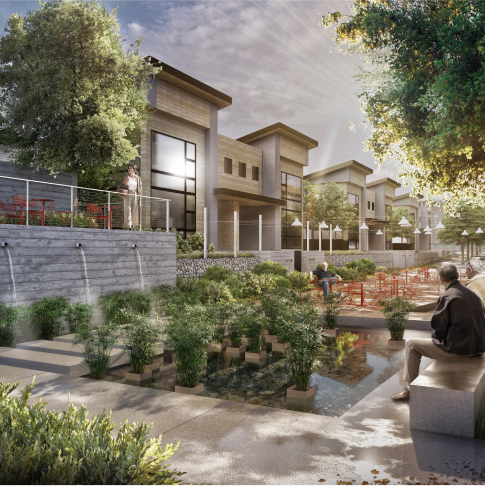
RDA Programs & Tools
The RDA provides loans, land write-downs, property acquisition and disposal, and tax increment reimbursements to aid in bringing redevelopment projects to fruition. The following financial programs and tools help to bridge the funding gap between a project’s economics and market realities.
Loan Program
The RDA’s traditional Loan Program assists property owners in the renovation, rehabilitation, and new construction of buildings within project area boundaries by providing critical gap financing for projects that advance project area goals. The RDA works closely with project developers and lenders to determine the level of funding that will best supplement existing, secured financing. Under specific circumstances, the Program may provide primary loans for projects that demonstrate a high level of community benefit. In support of the organization’s mission, the RDA can assume a higher level of risk than traditional lenders to ensure that transformative projects get built.
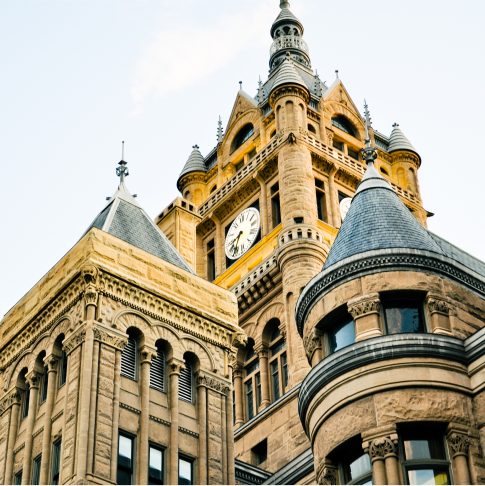
Granary District Adaptive Reuse Loan Program
Focusing on one of the RDA’s most industrial project areas, the Granary District Adaptive Reuse Loan Program provides forgivable loans to encourage the reuse and revitalization of the Granary District’s unique stock of buildings. The loans are intended to ease the sometimes daunting cost of the necessary building code updates local developers face when renovating aging warehouses and distressed industrial buildings. The Program has facilitated a number of transformative development projects that have increased the number of residents visiting the Granary District.
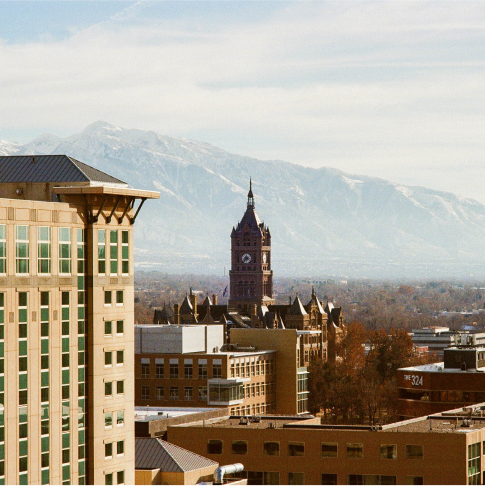
The Housing Development Loan Program (HDLP)
The HDLP centralizes the loan application, underwriting, and approval process across all City housing funding sources, providing a one-stop-shop for community partners. The HDLP provides low-cost financial assistance to incentivize the development and preservation of affordable housing within Salt Lake City municipal boundaries. While the RDA has been providing affordable housing loans for years, this program streamlines the application and approval process and better targets resources to needs within the community. Fiscal year 2022 was the second year the RDA’s multi-million Notice of Funding Availability process for affordable housing was run through the HDLP, having been run through our traditional loan program for three three years prior.
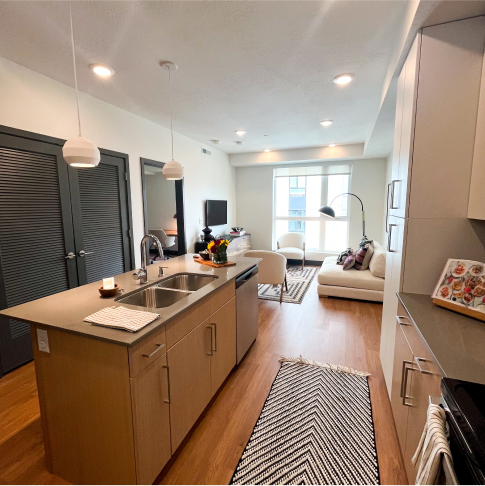
Tax Increment Reimbursement Program
The RDA’s Tax Increment Reimbursement Program helps achieve the project area goals by offering a tax increment reimbursement to developers for building eligible projects. The RDA will reimburse property owners or developers for construction costs associated with projects in RDA project areas that meet each project area’s strategic plan objectives. The amount of the tax increment reimbursement is determined by what the project generates, and the percentage of tax increment split between the RDA and developer.
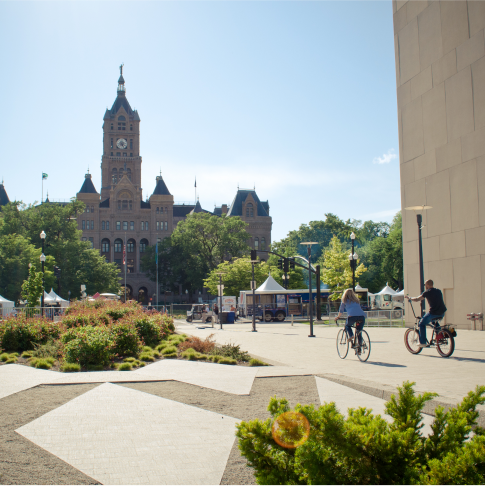
Property Acquisition
In addition to offering financial programs, the RDA also utilizes the tool of property acquisition to encourage project area development. The RDA often purchases underutilized property to market for strategic redevelopment, particularly to stimulate private investment, improve community conditions, and increase economic development.
